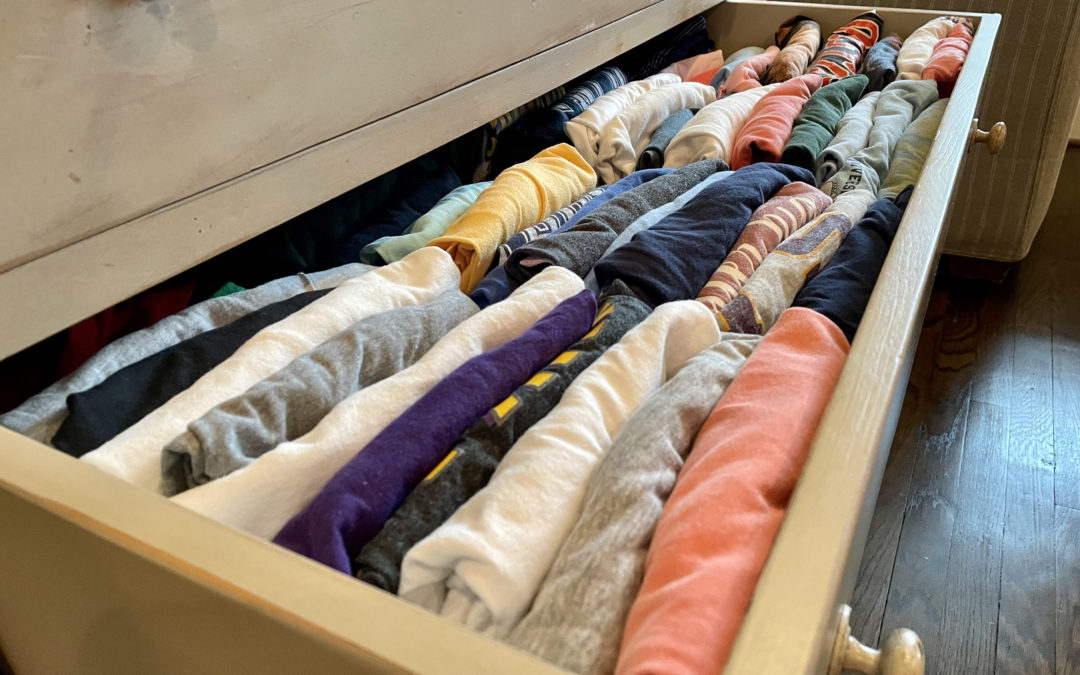During the Kon Mari tidying craze, I went through the shirts in my T-shirt drawer and got rid of the ones I never wore, or didn’t like, or that didn’t “spark joy.” I re-folded and arranged the survivors of the great purge, so they were standing in the drawer in neat columns. I’ve actually kept them this way.
Let me assure you that these rows of vertically-filed shirts that I decided to keep are not the cute athleisure ones with matching leggings and workout-to-brunch opportunities; they are mostly cotton, screen-printed, well-worn, kind of holey T-shirts. I wear them around the house, to sleep in, and when I decide don’t care who may see me looking like a college student with forehead wrinkles in Target.
My family and I are about to move, and it’s time to clean out closets and shelves before we pack. I’ve tried to re-evaluate what’s in that drawer. There are a lot of T-shirts in that drawer that could (should?) be donated, recycled, or thrown out, but I just can’t bring myself to do it. I have purged kids’ clothes and toys, kitchen items, and even other items of my own clothing, but I keep feeling emotionally attached to the entire drawer of T-shirts.
Some of them include:
Shirts from my undergraduate alma mater. The first T-shirt I ever bought on campus, for homecoming. Then there’s the one I bought when we went to a big bowl game, and the one I bought when I went back to teach there and needed something a little “nicer looking.”
One T-shirt from my Master’s alma mater. I have only one from those years, because I spent most of it abroad, where women don’t really wear these types of T-shirts. It represents the most transformative period of my life.
The Spanish National Team soccer jersey from 2008. It was the year they won the Eurocup and the year I left Spain to move back to the U.S.
A few T-shirts from the university where I spent five years getting my Ph.D. When I bought my first T-shirt after starting classes there, I remember being so proud to own it. How many hours did I spend reading, studying, and writing in those? Too many to count.
My husband’s college T-shirt. It’s been worn so soft and thin that it would probably tear down the side if you pulled it too hard. It has a hole near the bottom where he used to open beer bottles with it. Oh, college.
T-shirts from races. Some I ran while I was at the peak of my game, and some while I was trying to heal a broken heart.
A long-sleeved t-shirt from the place we honeymooned. A slice of bliss before the real work of marriage.
Some shirts from each of the schools at which I’ve taught. There is at least one spirit shirt from each place, including one that I bought a few sizes up to accommodate my belly while pregnant with my second baby.
Shirts from my husband’s medical training institution. These were some of the most challenging years of our lives, and when we met some treasured friends.
The shirts, it turns out, are not just timeworn articles of clothing; they are artifacts of my adult life thus far. These garments have clothed me on long runs, while writing my dissertation, while teaching on spirit days, while breastfeeding babies, while packing and moving some twenty times, and in a million other moments both exceptional and ordinary. They are an opportunity to recall times and spaces long past, and pieces of myself that are still part of who I am today.
“Our things embody our sense of self-hood and identity still further, becoming external receptacles for our memories, relationships, and travels.”
— Christian Jarret
For thousands of years, possessions have been connected to personal identity, and scholars have been studying this phenomenon for over a century. If you’re into this kind of thing, see, for example, William James (1890), Eugene Rochberg-Halton (1984), Russell Belk (1988), and Cheryl Harris (1993). More recently, psychologist Christian Jarret produced a TED talk in 2016 called “Why are we so attached to our things?” in which he explores the connections we make between our possessions and our personal identity.
Basically, in spite of our best efforts not to assign deep meaning to material objects, our brains are wired otherwise. It begins in childhood, and as we grow into adulthood, “our things embody our sense of self-hood and identity still further, becoming external receptacles for our memories, relationships, and travels,” writes Jarret in “The Psychology of Stuff and Things” (2013). This is why we may see so much more than colorful fabrics when we open a closet or a dresser drawer; we see the patchwork of our lives and of ourselves.
Of course, people may not have such a strong attachment to clothing or possessions, depending on the million possible circumstances of their lives, the culture in which they live, the strength of their ego, and their assurance of their personal identity. Jarrett explains: “How much we see our things as an extension of ourselves may depend in part on how confident we feel about who we are.” In my case, my life trajectory, values, and sense of self have been through so many iterations in the last twenty years that I do think the T-shirts in that drawer have greater meaning for me than if things had been more stagnant. These T-shirts are a literal record of my past, present, and future identities. Perhaps they are also a way to convey those identities to others, like a sports fan brandishing a jersey or a scarf to show their loyalty and right to belong.
Someday I’ll be dead and gone, and all my T-shirts and other possessions will eventually be gone, too. My existence will have been whittled down to a birth certificate, a death certificate, and the relationships I had with others. For right now, while I have to start detaching from one place to move to another, I’m letting these T-shirts and their other drawer-mates live out their twilight years to the fullest, holes and all. They remind me of who I am and where I’ve been. Who knows which ones may be added to the collection in years to come?
Yes, they are just T-shirts. But if you will excuse the pun, they are both holey and holy: holey, from clothing my body over many years of a lot of life; and holy, relics of the past, evidence of experiences and connections, vestments for a human body that lives and thinks and feels, and testaments of love given and received.



This is beautiful! I hope you will soon embrace the minimalism of letting those
T-shirts wipe your furniture’s dust – Except the Spain national soccer shirt!!!
I am right there with you! I have a whole drawer full from high school and beyond that I just can’t seem to part with. Beautifully written, as always.
Love this…makes me reflect on some possessions I cannot part with. Maybe you can get a quilt, throw or wall-hanging made of these t-shirts that will stay with you and then pass down to your kiddos with the history behind them.